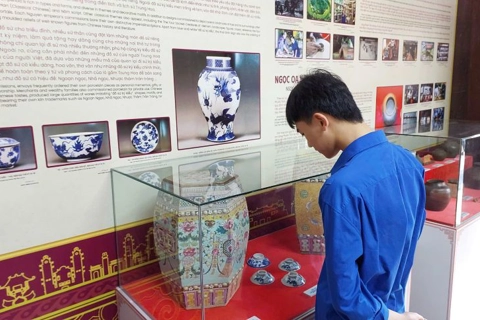As Hanoi's demand grows, publishers release more rare books
Book lovers in Hanoi enjoy collecting beautiful books, hand-printed with special techniques, as a way to respect the reading culture and the values of truth, goodness, and beauty.
THE HANOI TIMES — In Hanoi, more and more publishers are investing in designing and printing handmade books to accommodate the growing demand from collectors. Book lovers in the city are willing to spend a lot of money to own rare and fine books to show their respect for knowledge and reading culture.
A few years ago, a special edition of the book Beautiful and Magnificent Indochina by French photographer Pierre Dieulefils, which captured the landscape and life in Vietnam in the late 19th century, sold for VND130 million (US$5,200), or the special edition of The Godfather published by Dong A Company to celebrate the 50th anniversary of the work's first publication also hammered for VND260 million (US$10,400).
Book lovers' treasures
Book collecting has long been a hobby in Vietnamese society, but it has had its ups and downs for many reasons.
According to Yen Ba, a well-known journalist and book collector in Hanoi, the Vietnamese publishing industry produced a large number of luxury special editions in the early 20th century, especially in the 1930s and 1940s, after the French arrived in Vietnam and introduced printing technology. But historical ups and downs hindered the development of this kind of books.
-1742835388.jpg)
Collecting beautiful books is a hobby of many people in Hanoi. Photo: Ngo Minh/The Hanoi Times
In recent years, Vietnamese book collectors' thirst for special edition books (S editions) has been quenched as more and more publishers invest in this segment.
Dong A Company has focused on producing exquisite books. Its team has traveled to many European countries to meet contemporary bookbinding masters and visit bookbinding workshops, exhibitions, and handicraft book fairs.
Hanoi-based book collector Ngo Quang Minh said he was most impressed by the Dumb Luck edition, which was printed on Poonah paper and sewn in the classic European passé-carton style (centipede stitch), leaving the spine bare. The Kieu's Tale edition, printed by Dong A using the letterpress method, had the spine sewn in the Coptic style with double stitches in two colors of thread and a lacquered cover. The Vietnamese History in Pictures used the Danish millimetri binding style with a cover decorated with a combination of goatskin and fabric, while the motifs on the cover were embossed with gold foil and the book title label was plated with real gold.
"Rare handicraft books are a potential market for the publishing industry, as they honor authors and craftsmen such as bookbinding, leather stitching, gilding, lacquering, and open up more job opportunities for young people," Minh said.
-1742835387.jpg)
A special edition of a book with European-style binding. Photo: Ngo Minh/The Hanoi Times
In the past, many people thought that digital music would put an end to music CDs, and e-books were thought to be a threat to paper books. Reality has proven otherwise. Physical CDs and vinyl records are still popular, and rare books are still sought after.
"I believe that printed books still have a future. I hope that in the vast ocean of knowledge, good books and rare books will continue to find readers, people who love words, and become a treasure for future generations," said Minh.
Room for development
The Vietnamese publishing market is facing a hard time due to the emergence of new forms of entertainment, which requires publishers to innovate themselves to find the market.
Tran Dai Thang, Director of Dong A Company, said that Dong A's handmade book editions have won over the public and discerning collectors by producing limited editions and constantly adopting new techniques and aesthetics in design. Not only that, these books have also contributed greatly to shaping a new generation of collectors.
-1742835387.jpg)
Special editions of books on display at an exhibition in Hanoi. Photo: Ngo Minh/The Hanoi Times
Thang said books are not simply a means of conveying knowledge but also a work of art. In addition to valuable content, the form is also highly aesthetic, meeting the increasingly diverse spiritual needs of readers. Rare books are both a means of transmitting knowledge and a work of art.
"Cars have popular and premium versions. So why can't the book be diversified with special editions for passionate customers? I believe that if publishers are able, special editions will help raise the profile of Vietnamese books," Thang said.
-1742835388.jpg)
A book collector takes a picture of a unique book. Photo: Ngo Minh/The Hanoi Times
Sharing her experience in making rare books, Pham Thuy, Director of External Communications at Thai Ha Books, said that choosing books to make special editions is not difficult, but finding the idea to make each book special is.
Thai Ha Books has chosen to use Vietnamese folk materials associated with artisan villages to make the book covers. Each series will have its own materials chosen according to the content. The cover of The Book of Tea uses clay powder on bamboo paper to create mountain motifs and tea leaves for adornment.
Assessing the impact of the rare book collecting hobby on the current reading culture, poet Nguyen Quang Thieu, Chairman of the Vietnam Writers Association, said that readers have responded favorably to expensive and rare books, showing that Vietnamese book lovers feel a sense of ownership of high-quality and creatively produced publications.
Thieu said the criteria for books worth collecting include the design of the book, the illustrations, and the binding techniques, which require bookmakers to be constantly innovative and creative. Only then can each edition presented to collectors and readers who appreciate fine books be both an artistic creation and a book with significant content value.











